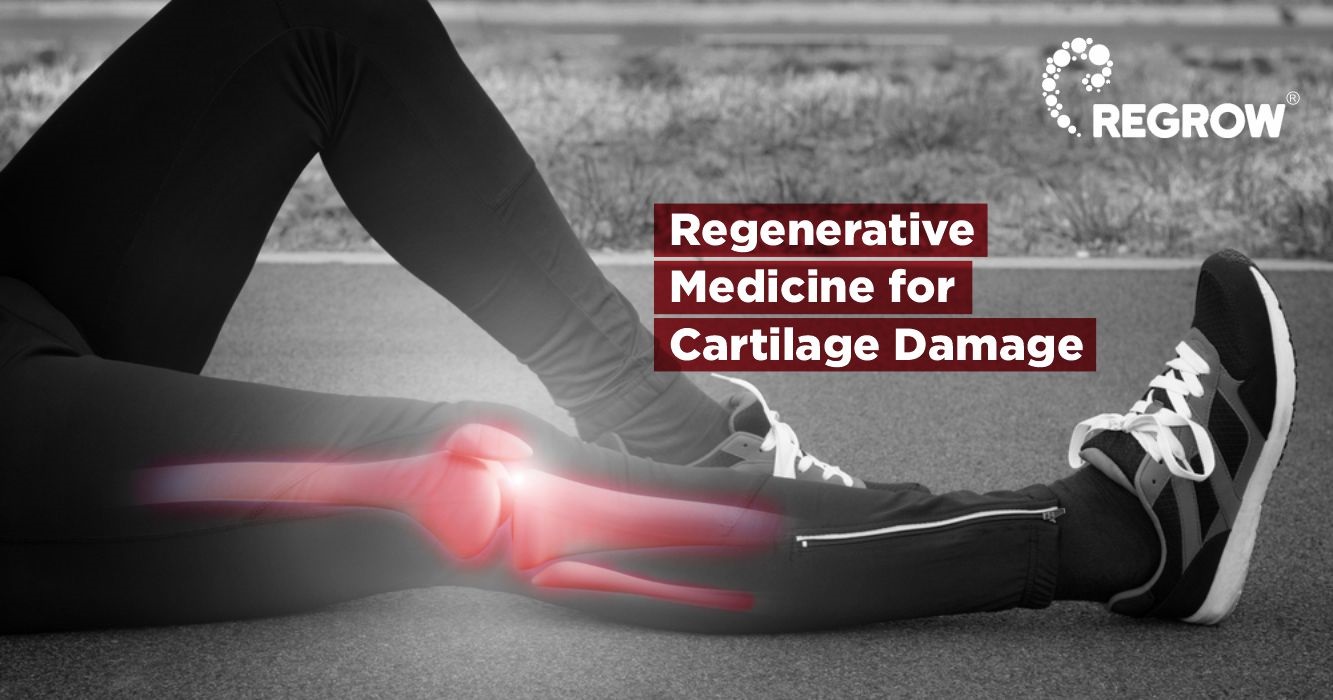© Copyright 2019. Regrow Biosciences Pvt Ltd. All Rights Reserved
Blog
© Copyright 2019. Regrow Biosciences Pvt Ltd. All Rights Reserved
Blog
Regenerative medicine for cartilage damage
5th July 2021

Orthopaedic conditions like bone injury or fractures can lead to pain or restricted movements. This needs immediate attention. In a similar way, cartilage damage in joints also leads to main and lack of mobility. It needs patient-specific treatment and a long duration of complete recovery. Regardless of the age, ignoring cartilage damage can lead to severe arthritic conditions. According to the statistics 10,000 people each year require a cartilage surgery. Accidents and sports injuries are the most common cause among young people, with most cases being under the 35-year-old demographic.
What is cartilage damage and its types?
Our body's basic framework is made of bones. Cartilage is the tissue that lies between two bones that make a joint. It works as a cushion, allowing smooth movements without friction. Cartilage is made up of cells called chondrocytes and collagen fibres. There are three types of cartilages, Hyaline, Elastic and Fibrous. The structure, composition and functions of these cartilages varies accordingly.
Cartilage tissue is a great shock absorber. Sport-specific activities like running, jumping, and climbing can happen with ease because of Hyaline cartilage that is present in various joints. These high impact actions can also lead to accidental injuries. Most of the time cartilage damage is associated with ligament, tendon, or bone injury. This can lead to a tear in cartilage. Deep injuries can even expose the bone underneath. Based on softness of cartilage and size of fissures cartilage damage can be classified from category Grade I to Grade IV
Common symptoms of cartilage damage
People with cartilage damage will experience inflammation, the area of injury swells and becomes warmer to touch with tenderness, soreness, and pain. They will also experience stiffness and a limited range of motions, as the damage progresses the affected limb will start to lose its mobility. In severe cases, the cartilage may chip off and the joints will become locked.
All this takes a toll on the normal routine of the person. It may require an absence of work. For sportspersons and professional dancers this can have a major impact on their career. If the right treatment at the right time is not taken, it might even end their careers. In today's hyper-active one, losing one's mobility can have serious repercussions.
How regenerative medicine can help
Since cartilage has no way to repair itself, with time the area of damage increases and gets more severe. Slowly, cartilage starts to degenerate. As the cartilage wears down, the bones of joints start to rub against each other. This can lead paint that makes a person immobile. Cartilage damage when ignored leads to severe arthritis.
Since the cartilage cannot heal itself it needs to be replaced by cartilage-like material. Regenerative medicine aims to regrow hyaline like cartilage cultured from one's own cartilage making tissue. Even though our body is slow in making new cartilage, these cells can be cultured to obtain millions of new cells. The procedure of using a patient's cartilage tissue to prepare a dose of cartilage making cells (Chondrocytes) is called Autologous Chondrocyte Implantation.
ACI treatment was first brought to India by Regrow Biosciences as Cartigrow. The Cartigrow treatment through cartilage cell therapy is a simple two step process. First step is a biopsy. In a minor arthroscopic procedure, a punch biopsy of healthy cartilage along with subchondral bones is taken. This is then transported carefully in a temperature-controlled way to the cell processing centre.
Cartilage making chondrocytes is then isolated and cultured and a number of quality control steps are taken. These cells are now ready to be transported. The entire procedure takes about 4 weeks. The second step of the treatment is implantation. In a procedure that requires 30 minutes, the injured area is prepared and a personalised dose of chondrocytes, made from the patient's own tissue is implanted in the area. The cell-gel mixture takes the shape of the defected area and settles in a firm jelly within 10 minutes. Slowly over the time, new cartilage formed. It is important to take physical therapy to heal completely. Exercise and rehabilitation is equally important post-implant for the patient to be up and active.
More than people have been treated by Cartigrow, cartilage cell therapy. It is available across 40+ cities and 350 hospitals like Apollo, Max-BLK, Fortis. KDAH, etc. Cartrigrow is a natural way of regenerating true cartilage tissues. The treatment causes the disease process to stop and not progress to arthritis. It is also manufactured and customised for each patient, meaning there is no possibility of rejection or side-effects. In a phase 3 Cell therapy conducted in India for evaluating the efficacy of Cartigrow ACI, 100% of the patients were relieved of pain & Xray + MRI showed complete regeneration of native cartilage. Moreover, it is a one-time treatment with no need of repeat surgery in future. The treatment is backed by many clinical trials, it is proven and experienced by doctors.
Regrow Biosciences is India's leading institution that works with Cell Therapy. It believes in cutting-edge innovation and delivering regenerative medicine-based solutions for finest human healthcare. Our treatment is a clinically new, meaningful and biological mode of therapy that offers the possibility of durably treating with lesser hospital stays and fuller recovery.
For more information, visit https://www.regrow.in/